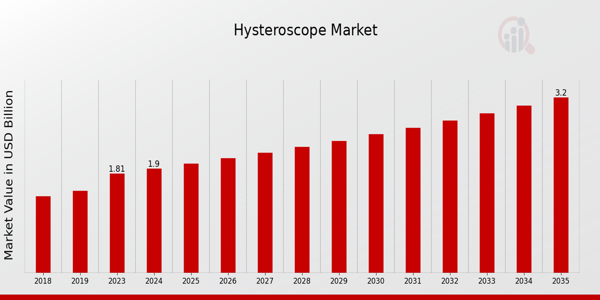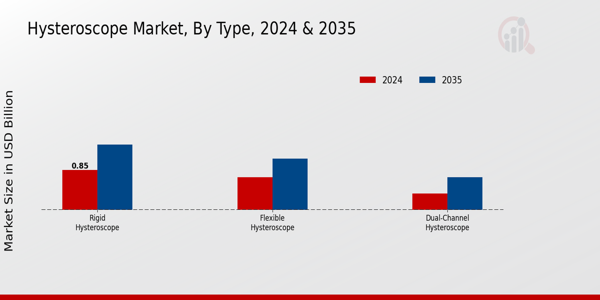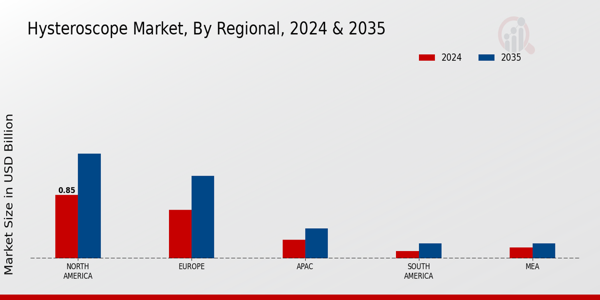Global Hysteroscope Market Overview
Hysteroscope Market Size was estimated at 1.81 (USD Billion) in 2023. The Hysteroscope Market Industry is expected to grow from 1.9(USD Billion) in 2024 to 3.2 (USD Billion) by 2035. The Hysteroscope Market CAGR (growth rate) is expected to be around 4.85% during the forecast period (2025 - 2035).

Source Primary Research, Secondary Research, MRFR Database and Analyst Review
Key Hysteroscope Market Trends Highlighted
The expansion of the hysteroscope market can be attributed to the increasing numbers of women suffering from gynecological problems and the growing elderly population, as well as the improvement of technology, including the development of advanced minimally invasive surgery techniques, which leads to better outcomes and shortened recovery periods. Additionally, there is a heightened concern about women's health coupled with the need for consulting professionals for treatment, ultimately to check or treat any underlying conditions, which is fueling the growth of the women's health problems diagnostics and therapeutics market. These factors are impacting the business as more clinics are purchasing modern hysteroscopes to enhance their services. The hysteroscope industry has multiple gaps that can be filled.
Emerging markets present a growing patient population, as improving healthcare infrastructure and increasing disposable incomes foster access to advanced medical technologies. Additionally, the development of innovative devices and accessories that enhance visualization and procedural efficiency can capture the attention of healthcare providers. Collaboration between manufacturers and healthcare institutions can lead to tailored solutions that meet specific clinical demands while potentially increasing market share. Trends in recent times indicate a shift towards the incorporation of artificial intelligence and robotics into hysteroscopy procedures.
These advancements aim to improve diagnostic accuracy and patient safety, allowing for better surgical outcomes. The increasing preference for outpatient procedures and remote monitoring is also notable, as these innovations allow patients to recover in the comfort of their homes. The combination of these trends highlights the evolving landscape of the hysteroscope market, where technology is playing a crucial role in shaping future advancements in women's health care. Overall, the market is poised for continued growth, driven by these key factors and innovations.
Hysteroscope Market Drivers
Increasing Prevalence of Gynecological Disorders
The Hysteroscope Market Industry is significantly driven by the increasing prevalence of various gynecological disorders globally. Conditions such as fibroids, polyps, endometrial hyperplasia, and malignancies have been on the rise, necessitating effective diagnostic and therapeutic measures. As healthcare providers strive to enhance patient outcomes through less invasive procedures, the demand for hysteroscopes is expected to surge. These devices allow for real-time visualization of the uterine cavity, making them invaluable for accurate diagnosis and treatment.
With a market valuation growth of 1.9 billion in 2024 and projections of reaching 3.2 billion by 2035, the urgency to address increasing gynecological health issues is motivating developments in hysteroscopic technology. Additionally, the rise in awareness among women regarding reproductive health and the benefits of early diagnosis is further propelling market growth. Healthcare systems are increasingly investing in advanced hysteroscopic systems which, combined with the trend of patient preference for minimally invasive procedures, boosts the Hysteroscope Market Industry.
The continuous evolution of medical technology, coupled with the large population base susceptible to women's health issues, ensures a favorable environment for market expansion, positioning it as a critical factor in addressing healthcare challenges.
Technological Advancements in Hysteroscopy
Technological advancements are a major driving force in the Hysteroscope Market Industry. Innovations in optical technology, instrumentation, and surgical techniques have transformed traditional hysteroscopy into more precise, efficient, and patient-friendly procedures. The introduction of high-definition video systems miniaturized flexible hysteroscopes, and novel treatment modalities have expanded the capabilities of hysteroscopy, enabling healthcare professionals to conduct a broader range of diagnostic and therapeutic interventions.
As more clinicians adopt these cutting-edge technologies, the overall demand for hysteroscopes is expected to rise, ensuring sustained market growth.
Rising Preference for Minimally Invasive Procedures
There is a marked shift towards minimally invasive surgical procedures within the healthcare community, driving the demand in the Hysteroscope Market Industry. Patients and medical professionals alike favor procedures that result in less trauma, quicker recovery times, and reduced hospital stays. Hysteroscopy aligns well with these preferences, offering a minimally invasive solution for diagnosing and treating various gynecological conditions.
This growing trend is likely to enhance the market's expansion further as more women opt for hysteroscopic interventions.
Hysteroscope Market Segment Insights
Hysteroscope Market Type Insights
The Hysteroscope Market, focusing on the Type segment, showcases a growing landscape with significant contributions from various product categories. In 2024, the entire market was valued at 1.9 USD Billion, with notable segmentations bringing out the diversity within the industry. The Rigid Hysteroscope dominates this landscape in terms of market value, standing at 0.85 USD Billion in 2024 and expected to grow to 1.4 USD Billion by 2035. This segment holds a majority share due to its established use in surgical procedures, offering superior imaging quality and ease of use in various diagnostic and therapeutic contexts.
Complementing this, the Flexible Hysteroscope features a market valuation of 0.7 USD Billion in 2024, projected to rise to 1.1 USD Billion by 2035, which underscores its importance in providing access to difficult anatomical areas with minimally invasive techniques. This growth indicates a shifting preference towards more patient-friendly options that enhance comfort and reduce recovery times, making it a significant player in the space. Meanwhile, the Dual-Channel Hysteroscope, valued at 0.35 USD Billion in 2024 and expected to reach 0.7 USD Billion by 2035, represents the least dominant segment, but it holds its relevance by facilitating simultaneous diagnostic and therapeutic procedures, which are increasingly favored in clinical practices.
As trends evolve toward minimally invasive surgical techniques, the importance of these types aligns with the growing demand for advanced gynecological treatments. The Hysteroscope Market data suggests that each type serves a specific need, with Rigid Hysteroscopes being preferred for more invasive surgical procedures, while Flexible Hysteroscopes cater to outpatient settings where quick recovery is essential. The variance in market statistics indicates that the competition among these types is influenced by advancements in technology and the increasing awareness of women's health issues. This diversification within the Hysteroscope Market segmentation reflects evolving surgical practices and patient preferences, presenting rich opportunities for innovation and growth within the industry.

Source Primary Research, Secondary Research, MRFR Database and Analyst Review
Hysteroscope Market Application Insights
The Hysteroscope Market, valued at 1.9 billion USD in 2024, is poised for steady growth, driven largely by its diverse applications in medical settings. This market, expanding in a landscape of increasing awareness and technological advancements, shows promising trends across various applications, particularly in Diagnostic Procedures, Surgical Procedures, and Therapeutic Procedures. Diagnostic Procedures play a critical role, as they enable precise examination and early detection of uterine abnormalities, thus supporting better patient outcomes.
Surgical Procedures are significant as they utilize advanced hysteroscopic techniques to perform minimally invasive surgeries, which are preferred for their reduced recovery time and complications. Therapeutic Procedures also dominate this segment, focusing on treatment options that cater to a wide range of gynecological conditions, further contributing to the rise in demand for hysteroscopes. The overarching growth in the healthcare sector, increasing prevalence of reproductive health issues, and advancements in hysteroscopic technologies are key drivers supporting the market's expansion, while challenges related to high costs and skilled professional training persist.
Overall, the Hysteroscope Market statistics highlight the importance of application variations in shaping the industry.
Hysteroscope Market End-Use Insights
The Hysteroscope Market was valued at 1.9 billion USD in 2024, reflecting its growth and significance within the healthcare sector. This market is primarily driven by the demand across various end-use environments, including hospitals, ambulatory surgical centers, and specialty clinics. Hospitals often provide the majority holding in this market segment due to advanced surgical capabilities and access to a broader range of patients requiring hysteroscopic procedures. Ambulatory surgical centers serve an important role as they offer cost-effective solutions and convenience for patients, enhancing overall access to minimally invasive procedures.
Specialty clinics also contribute significantly, focusing on tailored treatments and advanced technologies for distinct patient needs, thereby catering to niche markets. The evolving landscape of women's health, alongside the increasing prevalence of gynecological disorders, presents numerous growth opportunities within these end-use segments. However, challenges such as reimbursement issues and the need for skilled specialists could impact market efficiency. Overall, the Hysteroscope Market data reveals a promising environment for continued development and innovation across various healthcare facilities.
Hysteroscope Market Product Insights
The Hysteroscope Market is experiencing notable growth, reaching a value of 1.9 billion USD by 2024 and expanding significantly in subsequent years. This market encompasses various products, including Hysteroscopy Systems, Accessories and Consumables, and Visualization Systems, each playing a crucial role in modern gynecological procedures. Hysteroscopy Systems represent a core segment, providing essential tools for diagnosis and treatment, while Accessories and Consumables are vital for facilitating these procedures, ensuring optimal functionality and patient care.
Moreover, Visualization Systems enhance procedural accuracy and patient outcomes, thus contributing significantly to the overall market growth. The growing emphasis on minimally invasive surgeries and advancements in medical technology is driving demand within these product categories, while the need for effective diagnosis and treatment further supports market expansion. Market challenges include regulatory hurdles and the high cost of advanced systems; however, opportunities lie in technological innovations and increasing awareness of gynecological health, making the Hysteroscope Market a dynamic and evolving industry.
Hysteroscope Market Regional Insights
The Hysteroscope Market is experiencing steady growth across various regional segments. In 2024, North America held a dominant position, valued at 0.85 USD Billion, and is expected to expand to 1.4 USD Billion by 2035, indicating its majority holding in the market due to advanced healthcare infrastructure and high adoption rates of minimally invasive procedures. Europe follows, with a valuation of 0.65 USD Billion in 2024, expected to rise to 1.1 USD Billion by 2035, illustrating its significant contribution driven by growing awareness of women's health issues.
The APAC region stands at a valuation of 0.25 USD Billion in 2024 and is projected to reach 0.4 USD Billion by 2035, representing a growing market space propelled by rising disposable incomes and improving healthcare facilities. South America and MEA are relatively smaller markets, valued at 0.1 USD Billion and 0.15 USD Billion in 2024, respectively, anticipated to increase to 0.2 USD Billion by 2035, highlighting opportunities for growth in these regions as healthcare access improves. Overall, the Hysteroscope Market revenue reflects a diverse landscape where North America and Europe lead in market share due to their developed medical sectors, while APAC presents a promising arena for expansion.

Source Primary Research, Secondary Research, MRFR Database and Analyst Review
Hysteroscope Market Key Players and Competitive Insights
The Hysteroscope Market is characterized by a dynamic competitive landscape, marked by an array of established players and emerging companies determined to innovate and enhance product offerings. As advancements in medical technology continue to take shape, manufacturers are focusing on developing minimally invasive procedures that lead to quicker recovery times and improved patient outcomes. This evolving market landscape is driven by the increasing demand for surgical procedures related to women's health, combined with the growing awareness of effective diagnostic and treatment options for conditions such as abnormal uterine bleeding and infertility. Emerging markets and a rise in surgical centers are poised to introduce new competitive forces, leading to an array of strategic partnerships, mergers, and acquisitions among key players. Continuous research and development investments are vital as companies strive to differentiate their products within this competitive segment.
Hologic has established a notable presence within the Hysteroscope Market, primarily due to its commitment to innovative technology and comprehensive solutions for women's health. The company is recognized for delivering precise and reliable devices, which are crucial in diagnostic and therapeutic procedures. Hologic's strengths lie in its robust product offerings, which cater to a broad range of gynecological applications, thereby enhancing its market share and reputation. The company's focus on research and development allows it to stay ahead of the curve in addressing the evolving needs of healthcare professionals and patients. Furthermore, Hologic's strategic collaborations and partnerships strengthen its market position, enabling it to access new customer segments and enhance patient care through advanced hysteroscopic technologies.
Olympus holds a significant role in the Hysteroscope Market, leveraging its extensive experience in endoscopic technique and imaging technologies to provide high-quality hysteroscopes and related instruments. With a strong emphasis on quality and performance, Olympus ensures that its products not only meet but exceed industry standards, making it a preferred choice among healthcare providers. The company is well-known for its innovative designs that enhance visualization and maneuverability during procedures, which are vital in complex surgeries. Olympus's reach and commitment to training and education reinforce its strong market presence, as it supports healthcare professionals in effectively utilizing its hysteroscopic solutions. The combination of advanced technology and a customer-centric approach further cements Olympus's position as a key player in the Hysteroscope Market, presenting competitive advantages that resonate well with clinical requirements and surgical efficiency.
Key Companies in the Hysteroscope Market Include
-
Hologic
-
Olympus
-
Karl Storz
-
Cook Medical
-
Johnson and Johnson
-
ZIMMER BIOMET
-
Gyrus ACMI
-
Smith and Nephew
-
Boston Scientific
-
Richard Wolf
-
Conmed
-
Stryker
-
Ambu
-
Aesculap
-
Medtronic
Hysteroscope Market Industry Developments
Recent developments in the Hysteroscope Market highlight significant advancements and increased investments from major players. Companies such as Hologic and Olympus are focusing on innovative technologies to enhance the efficiency of hysteroscopic procedures, leading to improved patient outcomes. Additionally, Karl Storz and Cook Medical are expanding their product ranges to cater to emerging market demands. There has been a noticeable trend in mergers and acquisitions, with major entities like Johnson & Johnson and Stryker actively seeking partnerships to bolster their market position and leverage existing technologies. The growing emphasis on minimally invasive surgeries has driven market valuation increases, positively impacting companies like Boston Scientific and Conmed.
Furthermore, the surge in outpatient procedures has spurred growth opportunities for firms such as Ambu and Medtronic. Investment in research and development is evident across the industry as organizations strive to meet the evolving needs of healthcare providers. Companies such as Richard Wolf and Gyrus ACMI are also investing in training and education to enhance the proficiency of healthcare professionals in hysteroscopic techniques. Overall, the market is witnessing dynamic changes that reflect the ongoing evolution in minimally invasive surgical practices.
Hysteroscope Market Segmentation Insights
|
Report Attribute/Metric
|
Details
|
|
Market Size 2023
|
1.81(USD Billion)
|
|
Market Size 2024
|
1.9(USD Billion)
|
|
Market Size 2035
|
3.2(USD Billion)
|
|
Compound Annual Growth Rate (CAGR)
|
4.85% (2025 - 2035)
|
|
Report Coverage
|
Revenue Forecast, Competitive Landscape, Growth Factors, and Trends
|
|
Base Year
|
2024
|
|
Market Forecast Period
|
2025 - 2035
|
|
Historical Data
|
2019 - 2023
|
|
Market Forecast Units
|
USD Billion
|
|
Key Companies Profiled
|
Hologic, Olympus, Karl Storz, Cook Medical, Johnson and Johnson, ZIMMER BIOMET, Gyrus ACMI, Smith and Nephew, Boston Scientific, Richard Wolf, Conmed, Stryker, Ambu, Aesculap, Medtronic
|
|
Segments Covered
|
Type, Application, End Use, Product, Regional
|
|
Key Market Opportunities
|
Technological advancements in hysteroscopy, Increasing demand for minimally invasive surgeries, Rising prevalence of gynecological disorders, Growth in outpatient surgical procedures, Expanding market for diagnostic hysteroscopy
|
|
Key Market Dynamics
|
Technological advancements in devices, Increasing prevalence of gynecological disorders, Rising demand for outpatient procedures, Favorable reimbursement policies, Growing awareness and education programs
|
|
Countries Covered
|
North America, Europe, APAC, South America, MEA
|
Frequently Asked Questions (FAQ) :
The Global Hysteroscope Market is expected to be valued at 1.9 USD Billion in 2024.
By 2035, the Global Hysteroscope Market is projected to reach 3.2 USD Billion.
The expected CAGR for the Global Hysteroscope Market from 2025 to 2035 is 4.85%.
In 2024, North America is expected to hold the largest market share at 0.85 USD Billion.
The Flexible Hysteroscope segment is anticipated to be valued at 1.1 USD Billion in 2035.
Key players in the Global Hysteroscope Market include Hologic, Olympus, and Karl Storz among others.
The Dual-Channel Hysteroscope segment is expected to be valued at 0.35 USD Billion in 2024.
The market in Europe is estimated to grow from 0.65 USD Billion in 2024 to 1.1 USD Billion by 2035.
The market value for South America is expected to reach 0.2 USD Billion by 2035.
The Rigid Hysteroscope segment is expected to grow from 0.85 USD Billion in 2024 to 1.4 USD Billion in 2035.
















